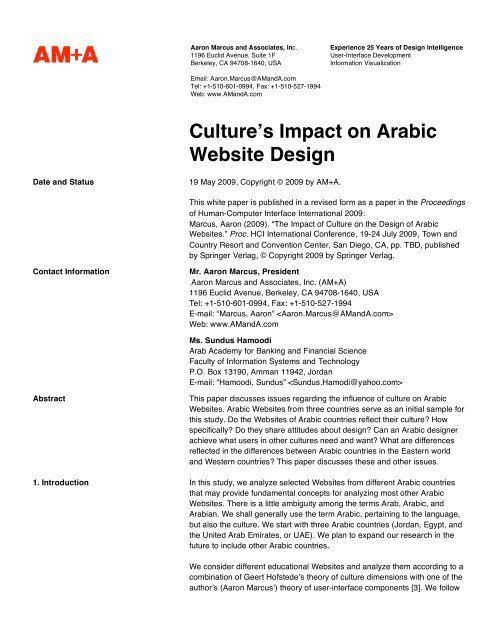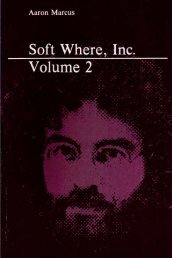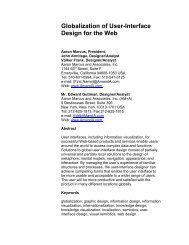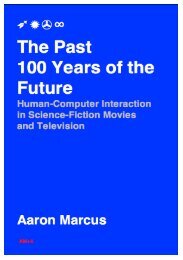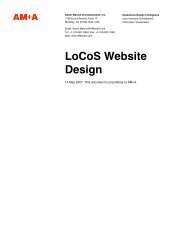Culture's Impact on Arabic Website Design - Aaron Marcus and ...
Culture's Impact on Arabic Website Design - Aaron Marcus and ...
Culture's Impact on Arabic Website Design - Aaron Marcus and ...
Create successful ePaper yourself
Turn your PDF publications into a flip-book with our unique Google optimized e-Paper software.
Aar<strong>on</strong> <strong>Marcus</strong> <strong>and</strong> Associates, Inc.1196 Euclid Avenue, Suite 1FBerkeley, CA 94708-1640, USAExperience 25 Years of <strong>Design</strong> IntelligenceUser-Interface DevelopmentInformati<strong>on</strong> Visualizati<strong>on</strong>Email: Aar<strong>on</strong>.<strong>Marcus</strong>@AM<strong>and</strong>A.comTel: +1-510-601-0994, Fax: +1-510-527-1994Web: www.AM<strong>and</strong>A.comCulture’s <str<strong>on</strong>g>Impact</str<strong>on</strong>g> <strong>on</strong> <strong>Arabic</strong><strong>Website</strong> <strong>Design</strong>Date <strong>and</strong> Status19 May 2009, Copyright © 2009 by AM+A.This white paper is published in a revised form as a paper in the Proceedingsof Human-Computer Interface Internati<strong>on</strong>al 2009:<strong>Marcus</strong>, Aar<strong>on</strong> (2009). “The <str<strong>on</strong>g>Impact</str<strong>on</strong>g> of Culture <strong>on</strong> the <strong>Design</strong> of <strong>Arabic</strong><strong>Website</strong>s.” Proc. HCI Internati<strong>on</strong>al C<strong>on</strong>ference, 19-24 July 2009, Town <strong>and</strong>Country Resort <strong>and</strong> C<strong>on</strong>venti<strong>on</strong> Center, San Diego, CA, pp. TBD, publishedby Springer Verlag, © Copyright 2009 by Springer Verlag.C<strong>on</strong>tact Informati<strong>on</strong>Mr. Aar<strong>on</strong> <strong>Marcus</strong>, PresidentAar<strong>on</strong> <strong>Marcus</strong> <strong>and</strong> Associates, Inc. (AM+A)1196 Euclid Avenue, Berkeley, CA 94708-1640, USATel: +1-510-601-0994, Fax: +1-510-527-1994E-mail: “<strong>Marcus</strong>, Aar<strong>on</strong>” Web: www.AM<strong>and</strong>A.comMs. Sundus HamoodiArab Academy for Banking <strong>and</strong> Financial ScienceFaculty of Informati<strong>on</strong> Systems <strong>and</strong> TechnologyP.O. Box 13190, Amman 11942, JordanE-mail: “Hamoodi, Sundus” AbstractThis paper discusses issues regarding the influence of culture <strong>on</strong> <strong>Arabic</strong><strong>Website</strong>s. <strong>Arabic</strong> <strong>Website</strong>s from three countries serve as an initial sample forthis study. Do the <strong>Website</strong>s of <strong>Arabic</strong> countries reflect their culture? Howspecifically? Do they share attitudes about design? Can an <strong>Arabic</strong> designerachieve what users in other cultures need <strong>and</strong> want? What are differencesreflected in the differences between <strong>Arabic</strong> countries in the Eastern world<strong>and</strong> Western countries? This paper discusses these <strong>and</strong> other issues.1. Introducti<strong>on</strong> In this study, we analyze selected <strong>Website</strong>s from different <strong>Arabic</strong> countriesthat may provide fundamental c<strong>on</strong>cepts for analyzing most other <strong>Arabic</strong><strong>Website</strong>s. There is a little ambiguity am<strong>on</strong>g the terms Arab, <strong>Arabic</strong>, <strong>and</strong>Arabian. We shall generally use the term <strong>Arabic</strong>, pertaining to the language,but also the culture. We start with three <strong>Arabic</strong> countries (Jordan, Egypt, <strong>and</strong>the United Arab Emirates, or UAE). We plan to exp<strong>and</strong> our research in thefuture to include other <strong>Arabic</strong> countries.We c<strong>on</strong>sider different educati<strong>on</strong>al <strong>Website</strong>s <strong>and</strong> analyze them according to acombinati<strong>on</strong> of Geert Hofstede’s theory of culture dimensi<strong>on</strong>s with <strong>on</strong>e of theauthor’s (Aar<strong>on</strong> <strong>Marcus</strong>’) theory of user-interface comp<strong>on</strong>ents [3]. We follow
AM+A.Document: Culture’s <str<strong>on</strong>g>Impact</str<strong>on</strong>g> <strong>on</strong><strong>Design</strong> of <strong>Arabic</strong> <strong>Website</strong>sFile: AM+A_XCult<strong>Arabic</strong>_19May09.docPage 2Aar<strong>on</strong> <strong>Marcus</strong> <strong>and</strong> Associates, Inc.www.AM<strong>and</strong>A.comthe assumpti<strong>on</strong>s about culture markers that <strong>Marcus</strong> introduced in previousstudies [4, 5].1.1 Hofstede’s Model of CultureOne of the culture models more widely used by researchers <strong>and</strong> Webdesigners is Hofstede’s model [2]. Hofstede formulated his model of culturedimensi<strong>on</strong>s based <strong>on</strong> surveys <strong>and</strong> interviews with several hundred IBMemployees, originally in 53 countries during (1978-1983), since exp<strong>and</strong>ed to74 countries in the sec<strong>on</strong>d editi<strong>on</strong> of his book describing his theory. Using hissurvey, augmented by later studies, Hofstede determined pattern ofsimilarities <strong>and</strong> differences in how signs, rituals, heroes/heroines, <strong>and</strong> valuesare expressed by group members. Hofstede’s culture dimensi<strong>on</strong>s, or indices,are the following:Power Distance: high vs. low.Individuality: high vs. low (i. e., Collectivist).Uncertainty Avoidace: high vs. low.Gender Role Differences: masculinity vs. femininity.Time Orientati<strong>on</strong>: l<strong>on</strong>g-term vs. short-term.1.2 <strong>Marcus</strong>’s Model of User InterfacesHuman-computer interface designers try to determine the most usable(effective, efficient, <strong>and</strong> satisfying, according to the definiti<strong>on</strong> of theInternati<strong>on</strong>al St<strong>and</strong>ards Organizati<strong>on</strong> in Geneva) means to communicate thefuncti<strong>on</strong>s <strong>and</strong> data, or tools <strong>and</strong> c<strong>on</strong>tent, of computer-based media. Everyphase of development must c<strong>on</strong>sider users’ needs, wants, requirements, <strong>and</strong>expectati<strong>on</strong>s. The development tasks (essentially verbs modeled <strong>on</strong> softwaredevelopment tasks) include planning, researching, analyzing, designing,implementing, evaluating, documenting, training, <strong>and</strong> maintaining. Ultimately,these tasks must account for the cultural attributes of the target market ofusers. <strong>Marcus</strong> developed five essential comp<strong>on</strong>ents (or nouns) of usercentered,user-interface development. Those comp<strong>on</strong>ents are useful in allstages of development:Metaphors: Essential c<strong>on</strong>cepts c<strong>on</strong>veyed through images, words, sounds,touches, <strong>and</strong> even smells.Mental model: Organizati<strong>on</strong> of data, functi<strong>on</strong>s, c<strong>on</strong>tent, tools, tasks, roles,<strong>and</strong> people.Navigati<strong>on</strong>: Techniques of moving through the mental model, such as links,butt<strong>on</strong>s, dialogue boxes, panels, <strong>and</strong> windows.Interacti<strong>on</strong>: Techniques of input, output, <strong>and</strong> the overall behavior ofsystems.Presentati<strong>on</strong>: Visual appearance characteristics, such as typography, color,layout, sequencing; verbal characteristics, tactile characteristics, s<strong>on</strong>iccharacteristics, <strong>and</strong> aromatic characteristics.1.3 Objectives of the StudyThis paper has several objectives:
AM+A.Document: Culture’s <str<strong>on</strong>g>Impact</str<strong>on</strong>g> <strong>on</strong><strong>Design</strong> of <strong>Arabic</strong> <strong>Website</strong>sFile: AM+A_XCult<strong>Arabic</strong>_19May09.docPage 4Aar<strong>on</strong> <strong>Marcus</strong> <strong>and</strong> Associates, Inc.www.AM<strong>and</strong>A.cominformati<strong>on</strong> he/she needs. The official university logo reflects the historicalbackground of the country <strong>and</strong> the civilizati<strong>on</strong>. This c<strong>on</strong>notati<strong>on</strong> may satisfythose who which wish to emphasize high-power orientati<strong>on</strong> <strong>and</strong> perhaps toemphasize a l<strong>on</strong>g-term time orientati<strong>on</strong>. The colors of the <strong>Website</strong> are dark,<strong>and</strong> the <strong>Website</strong> seems to reflect a str<strong>on</strong>g masculine orientati<strong>on</strong>.Many links <strong>and</strong> menus can found in this <strong>Website</strong>. The orientati<strong>on</strong> of the sitetowards tasks <strong>and</strong> roles suggest a masculine perspective. Full informati<strong>on</strong>,easy navigati<strong>on</strong>, <strong>and</strong> easy access to informati<strong>on</strong> all help to clarify the user’sunderst<strong>and</strong>ing <strong>and</strong> provide a str<strong>on</strong>g incentive to remain at the <strong>Website</strong>.Figure 2: Al-Zayto<strong>on</strong>ah University (Jordan), http://www.alzayto<strong>on</strong>ah.edu.joFigure 3: Applied Science University (Jordan), http://aspu.edu.jo
AM+A.Document: Culture’s <str<strong>on</strong>g>Impact</str<strong>on</strong>g> <strong>on</strong><strong>Design</strong> of <strong>Arabic</strong> <strong>Website</strong>sFile: AM+A_XCult<strong>Arabic</strong>_19May09.docPage 5Aar<strong>on</strong> <strong>Marcus</strong> <strong>and</strong> Associates, Inc.www.AM<strong>and</strong>A.comLike many similar university <strong>Website</strong>s, the images of this universityarchitecture <strong>and</strong> a logo in Figure 3 represent the university’s history <strong>and</strong>importance. The metaphorical references to the university are simple <strong>and</strong>clear: university m<strong>on</strong>uments <strong>and</strong> laboratories. The <strong>Website</strong> does not providea challenge to the user; rather it reflects a calm experience, through its color<strong>and</strong> relative simplicity. Throughout the <strong>Website</strong>, there are many pictures ofthe university's leaders, but these do not appear in the Home page. Therealso seem to be many distinct passwords menti<strong>on</strong>ed, but they do notinterfere with rapidly exploring the c<strong>on</strong>tent. Passwords generally indicate ahigh power-distance value, with some moderati<strong>on</strong> in this site.The mental model seems clear, <strong>and</strong> the c<strong>on</strong>tent is classified, organized, <strong>and</strong>distributed effectively throughout the <strong>Website</strong>. For example, a secti<strong>on</strong> offersanswers to frequently asked questi<strong>on</strong>s. Menus presented in a clear way helpthe user to keep in c<strong>on</strong>trol <strong>and</strong> navigate effectively. This <strong>Website</strong> seems toemphasize c<strong>on</strong>cern with social issues <strong>and</strong> culture, satisfying people with highuncertainty-avoidance.The site could be classified as a l<strong>on</strong>g-term time-orientati<strong>on</strong> <strong>Website</strong>, becauseit maintains its relati<strong>on</strong> with students who have graduated. In additi<strong>on</strong>, thesite allows users to deliver their questi<strong>on</strong>s <strong>and</strong> opini<strong>on</strong>s through E-mail indifferent ways. This feature emphasizes the <strong>Website</strong> as more interactive. TheWeb served the individualism for both students <strong>and</strong> other users, <strong>and</strong> it couldbe c<strong>on</strong>sidered as a task-oriented <strong>Website</strong>.Figure 4: Al Isra University (Jordan), http://www.isra.edu.joThe <strong>Website</strong> of Figure 4 displays a logo that represents the university’simportance at the top right side. The mental model has is richly categorized<strong>and</strong> deeply structured. Many links <strong>and</strong> menus appear in the Home page tohelp with navigati<strong>on</strong>. There are issues of security, as indicated by offering the
AM+A.Document: Culture’s <str<strong>on</strong>g>Impact</str<strong>on</strong>g> <strong>on</strong><strong>Design</strong> of <strong>Arabic</strong> <strong>Website</strong>sFile: AM+A_XCult<strong>Arabic</strong>_19May09.docPage 6Aar<strong>on</strong> <strong>Marcus</strong> <strong>and</strong> Associates, Inc.www.AM<strong>and</strong>A.comopti<strong>on</strong> of restricting access (for university students <strong>and</strong> employees) in this<strong>Website</strong>.This site appears masculine in design because of its orientati<strong>on</strong> towardstasks <strong>and</strong> roles. The primary colors used for this website are white <strong>and</strong> blue.Figure 5: Zayed University (UAE), http://www.zu.ac.ae3. Comparis<strong>on</strong>s of <strong>Website</strong>s 3.1 General Observati<strong>on</strong>sThe Home page in Figure 5 shows an image of leaders al<strong>on</strong>g with multimediaanimati<strong>on</strong> effects. What makes this site different is that the universityspecializes in female students; therefore, images of female students appear<strong>on</strong> the Home page.The well-designed site in Figure 5 is accessed with fewer authenticati<strong>on</strong> <strong>and</strong>password rituals, unless they are necessary, making it seem less highpower-distance oriented. The links to internal <strong>and</strong> external <strong>Website</strong>s seemeasily found <strong>and</strong> selected, making navigati<strong>on</strong> easy. The links or menusprovide a clear hierarchy <strong>and</strong> complete informati<strong>on</strong>, making the site suitablefor high-uncertainty- avoidance users. Visitors can reach any informati<strong>on</strong> <strong>and</strong>functi<strong>on</strong>s they require. Multimedia effects found at the site seem suitable fora wide range of visitors. The primary colors of the <strong>Website</strong> are red <strong>and</strong> white.The <strong>on</strong>ly language used in the <strong>Website</strong> is English, which may be a barrier tosome <strong>Arabic</strong>-speaking students.Some general observati<strong>on</strong>s about these <strong>Website</strong>s are the following:According to [1], Callahan’s study of university <strong>Website</strong> design, mostuniversity <strong>Website</strong>s have a banner with the name of the university, auniversity logo <strong>and</strong>/or university seal, <strong>and</strong> images of university buildings <strong>and</strong>people. Most of the universities treat the <strong>Website</strong> as a visible representati<strong>on</strong>
AM+A.Document: Culture’s <str<strong>on</strong>g>Impact</str<strong>on</strong>g> <strong>on</strong><strong>Design</strong> of <strong>Arabic</strong> <strong>Website</strong>sFile: AM+A_XCult<strong>Arabic</strong>_19May09.docPage 7Aar<strong>on</strong> <strong>Marcus</strong> <strong>and</strong> Associates, Inc.www.AM<strong>and</strong>A.comof their values, <strong>and</strong> of their “products”, namely, students <strong>and</strong> educati<strong>on</strong>.Therefore, Callahan found str<strong>on</strong>g similarities in <strong>Website</strong> design acrosscountries within this single genre. The authors found educati<strong>on</strong>al <strong>Arabic</strong><strong>Website</strong>s shared these characteristics with most university <strong>Website</strong>s.Most <strong>Arabic</strong> <strong>Website</strong>s also shared the characteristic of reflecting high powerdistancethrough the pictures, the structure or organizati<strong>on</strong> of the design, <strong>and</strong>access to informati<strong>on</strong>. The authors also found similarities in the way the sitesoffer navigati<strong>on</strong> through links <strong>and</strong> menus to reach different internal pages<strong>and</strong> external sites.In terms of individualism or collectivism, it appears that most of the <strong>Arabic</strong><strong>Website</strong>s studied gave more attenti<strong>on</strong>s to individuals than to groups, which issomewhat atypical, perhaps arising from the educated community of users.<strong>Arabic</strong> university <strong>Website</strong>s may use different languages (<strong>Arabic</strong> <strong>and</strong>/orEnglish). The English-language usage raises the questi<strong>on</strong> of whether thelanguage presents a barrier to local <strong>Arabic</strong> visitors or not, especially if thedesign is <strong>on</strong>ly in English.Graphics (images) appear in most of these <strong>Arabic</strong> university Web sites. Theyare not purely text-oriented.3.2 Use of ColorColor is an essential characteristic of appearance that is influenced byculture. According to Callahan [1] in the study “Cultural Similarities <strong>and</strong>Differences in the <strong>Design</strong> of University <strong>Website</strong>s,” Callahan made thefollowing observati<strong>on</strong>s:In Malaysian sites, a white background was comm<strong>on</strong>ly chosen in (17 sites),but in three other cases, the background was purple or blue.Swedish sites displayed a str<strong>on</strong>g preference, also, for a white background(18 sites). Colors were used carefully as a background for links. Blue <strong>and</strong>yellow, the Swedish nati<strong>on</strong>al colors are a frequent theme, in additi<strong>on</strong> to grey,purple, pink, <strong>and</strong> dark red.In Greek university <strong>Website</strong>s, two color schemes are often used. Nine<strong>Website</strong>s were designed in various shades of blue. 11 <strong>Website</strong>s usedvarious shades of brown <strong>and</strong> yellow, <strong>and</strong> many of those sites used ancientGreek art as a central visual theme of the page design. Only two sitesdisplayed brighter, livelier colors.In the present study of <strong>Arabic</strong> university <strong>Website</strong>s, two color schemes seemto dominate, the use of blue <strong>and</strong> green, which is a frequent theme of <strong>Arabic</strong>visual communicati<strong>on</strong>. A white background was also comm<strong>on</strong>ly chosen for<strong>Arabic</strong> Web sites.3.3 Mental Model or Informati<strong>on</strong> ArchitectureIn regard to the mental model, or the structure of c<strong>on</strong>tent, Callahan [1] foundthat two of the most important criteria of Web design are page orientati<strong>on</strong>(horiz<strong>on</strong>tal vs. vertical) <strong>and</strong> the number of links existing within the pages.
AM+A.Document: Culture’s <str<strong>on</strong>g>Impact</str<strong>on</strong>g> <strong>on</strong><strong>Design</strong> of <strong>Arabic</strong> <strong>Website</strong>sFile: AM+A_XCult<strong>Arabic</strong>_19May09.docPage 8Aar<strong>on</strong> <strong>Marcus</strong> <strong>and</strong> Associates, Inc.www.AM<strong>and</strong>A.comRegarding orientati<strong>on</strong>, Austria <strong>and</strong> Denmark have a preference for horiz<strong>on</strong>talpage design, while Japan <strong>and</strong> Malaysia have a preference for a verticallayout. The current study shows that most of <strong>Arabic</strong> university <strong>Website</strong> pagesuse a horiz<strong>on</strong>tal orientati<strong>on</strong> <strong>and</strong> a large number of links within the <strong>Website</strong>.4. C<strong>on</strong>clusi<strong>on</strong>s <strong>and</strong> Future Directi<strong>on</strong>s As stated in the objectives above, this initial study seeks to discover whatdifferences <strong>and</strong> similarities in design are apparent within <strong>Arabic</strong> <strong>Website</strong>s<strong>and</strong> whether these differences <strong>and</strong> similarities corresp<strong>on</strong>d to characteristicspredicted by culture models. The examples shown do seem to exhibitpatterns that corresp<strong>on</strong>d to those described in discussi<strong>on</strong>s of culturedimensi<strong>on</strong>s based <strong>on</strong> culture models.From this initial study, the authors found that <strong>Arabic</strong> <strong>Website</strong>s exhibit certaincharacteristics <strong>and</strong> may need to c<strong>on</strong>sider changes:Most pictures focus <strong>on</strong> university buildings. <strong>Arabic</strong> <strong>Website</strong>s may wish toc<strong>on</strong>sider more representative pictures.Most do not feature multimedia. They may wish to c<strong>on</strong>sider more multimediac<strong>on</strong>tent.Most do not invite student activities <strong>and</strong> input. They may wish to c<strong>on</strong>sidermore sharing <strong>and</strong> student activity.Most offer limited external links. They may wish to add more links to external<strong>Website</strong>s.Most offer less Help <strong>and</strong> documentati<strong>on</strong>. They may wish to add more to their<strong>Website</strong> designs.They may wish to c<strong>on</strong>sider adding more multilingual c<strong>on</strong>tent. <strong>Design</strong>ing an<strong>Arabic</strong> <strong>Website</strong> in English-<strong>on</strong>ly may be c<strong>on</strong>sidered a barrier to access for<strong>Arabic</strong> users.Based <strong>on</strong> a small number of interviews with students who use the <strong>Website</strong>sfor doing tasks, the following comments were collected:Students want/need more pictures of university buildings <strong>and</strong> students indifferent areas of the university.Students want/need more frequently updated informati<strong>on</strong> <strong>and</strong> more specificc<strong>on</strong>tent that can answer frequently asked questi<strong>on</strong> by both new <strong>and</strong>experienced students.Most users would like to see blue <strong>and</strong> gray colors in the <strong>Website</strong>s.<strong>Website</strong>s need more interactive design features.Based <strong>on</strong> the analysis thus far, the study of <strong>Arabic</strong> <strong>Website</strong>s needs to beexp<strong>and</strong>ed to cover different types of <strong>Website</strong>s, other <strong>Arabic</strong> countries, <strong>and</strong>more extensive interviews with students <strong>and</strong> faculty to gather usage data.In future analysis, the authors plan to examine university <strong>Website</strong>s in greaterdetail <strong>and</strong> to exp<strong>and</strong> the analysis to other <strong>Website</strong> genres (e.g., e-commercesites, government sites, travel sites, etc.) <strong>and</strong> to other <strong>Arabic</strong> countries notcovered in the present study.5. References The following are references cited in the text.
AM+A.Document: Culture’s <str<strong>on</strong>g>Impact</str<strong>on</strong>g> <strong>on</strong><strong>Design</strong> of <strong>Arabic</strong> <strong>Website</strong>sFile: AM+A_XCult<strong>Arabic</strong>_19May09.docPage 9Aar<strong>on</strong> <strong>Marcus</strong> <strong>and</strong> Associates, Inc.www.AM<strong>and</strong>A.com[1] Callahan, E.: Cultural Similarities <strong>and</strong> Differences in the <strong>Design</strong> of University<strong>Website</strong>s. Journal of Computer-Mediated Communicati<strong>on</strong>, Vol. 11(1), No.1,Article 12. http://jcmc.indiana.edu/vol11/issue1/callahan.html (2005)[2] Hofstede, G., Hofstede, G.J.: Cultures <strong>and</strong> Organizati<strong>on</strong>s: Software of theMind. New York: McGraw-Hill. See also: http://www.geert-hofstede.com(2005)[3] <strong>Marcus</strong>, A.: Globalizati<strong>on</strong> of User-Interface <strong>Design</strong> for the Web. Proceedingsof 1st Internati<strong>on</strong>al C<strong>on</strong>ference <strong>on</strong> Internati<strong>on</strong>alizati<strong>on</strong> of Products <strong>and</strong>Systems (IWIPS), Girish Probhu <strong>and</strong> Elisa M. Delgaldo, eds., 22-22 May,1999, Rochester, NY, Backhouse Press, Rochester, NY, USA, ISBN: 0-965691-2-2, 165--172 (1999)[4] <strong>Marcus</strong>, A., Gould, E.W.: Crosscurrents: Cultural Dimensi<strong>on</strong>s <strong>and</strong> GlobalWeb User-Interface <strong>Design</strong>. Interacti<strong>on</strong>s, ACM Publisher, www.acm.org, Vol.7, No. 4, July/August 2000, 32--46 (2000)[5] <strong>Marcus</strong>, A., Baumgartner, V.J.: Mapping User-Interface <strong>Design</strong> Comp<strong>on</strong>entsvs. Culture Dimensi<strong>on</strong>s in Corporate <strong>Website</strong>s. Visible Language, MIT Press,38:1, 1--65 (2004)6. Supplementary References The following are references relevant to the paper.[6] Evers, V.: Cross-Cultural Underst<strong>and</strong>ing of Graphical Elements <strong>on</strong> theDirectED <strong>Website</strong>. Proceedings of Annual Workshop <strong>on</strong> Cultural Issues <strong>on</strong>HCI, 5 December 2001, 3--8 (2001)[7] Fitzgerald, W.: Models for Cross-Cultural Communicati<strong>on</strong>s for Cross-Cultural<strong>Website</strong> <strong>Design</strong>. Nati<strong>on</strong>al Research Council of Canada, NRC-CNRC, 2004,3--8 (2004)[8] Hamoodi, S., Sheikh, A.E.: The <str<strong>on</strong>g>Impact</str<strong>on</strong>g> of Culture <strong>on</strong> <strong>Design</strong> <strong>and</strong> UsabilityInternati<strong>on</strong>al. Proceedings of Internati<strong>on</strong>al C<strong>on</strong>ference <strong>on</strong> Informati<strong>on</strong> <strong>and</strong>Knowledge Engineering, Las Vegas, NV, USA, June 25-28 2007, 285--288(2007)[9] Khaslavsky, J.: Integrating Culture into Interface <strong>Design</strong>. CHI 98 C<strong>on</strong>ferenceSummary <strong>on</strong> Human Factors in Computing Systems, Los Angeles, CA, ACMPress, 1998, 365--366 (1998)[10] Komlodi, A., Carlin, M.: Identifying Cultural Variables in Informati<strong>on</strong>-Seeking.Proceedings of the Tenth Americans C<strong>on</strong>ference <strong>on</strong> Informati<strong>on</strong> Systems,New York, August 2004, 3--5 (2004)[11] Lo, B.W.N., G<strong>on</strong>g, P.: Cultural <str<strong>on</strong>g>Impact</str<strong>on</strong>g> <strong>on</strong> the <strong>Design</strong> of e-Commerce<strong>Website</strong>s, Part 1: Site Format <strong>and</strong> Layout. Issues in Informati<strong>on</strong> Systems,6:2, 2005, 182--189 (2005)[12] Sim<strong>on</strong>, S.J.: The <str<strong>on</strong>g>Impact</str<strong>on</strong>g> of Culture <strong>and</strong> Gender <strong>on</strong> Web Sites: An EmpiricalStudy. The Data Base for Advances in Informati<strong>on</strong> Systems, Vol.32, No.1,2001, 21--27 (2001)[13] Zahedi, F.“Marim”, Van Pelt, W,V., S<strong>on</strong>g, H.: A C<strong>on</strong>ceptual Framework forInternati<strong>on</strong>al Web <strong>Design</strong>. IEEE Transacti<strong>on</strong> <strong>on</strong> Professi<strong>on</strong>al Communicati<strong>on</strong>,Vol. 44, No.2, 2001, 83--86 (2001)


